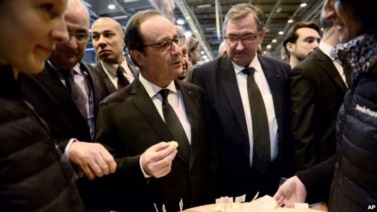The Dupont Circle park in Washington DC is a busy, crowded place. Popular restaurants and businesses around the circle attract many city residents and visitors. But few people know about the old streetcar station below the street.
Braulio Agnese is the Managing Director of an organization called Dupont Underground. The group wants to change the old station into a place for the arts.
"We see everything from site-specific art work, that fills the space in different ways, light and sound or installations. Or it can be used like a traditional gallery. But also as a curved space, it offers a chance for new kinds of performance. The DC has quite a few experimental theater groups that would like to work in an unusual space and do different kinds of production.'
The system of tunnels was built in the late 1940s. But the streetcars only ran for a short time. They stopped running in the 1960s. Mr. Agnese says the station could become a symbol of how quickly Washington is changing.
"Changes in the last five or ten years have been tremendous. The restaurant scene is changing, new development, new opportunities. We think there is an opportunity to create something here that helps the city to move forward."
Dupont Underground is just one example of the trend toward giving a new purpose to unused industrial sites. In New York, builders want to make a forgotten street car garage into a park below the street. And New York already has the popular High Line Park. It was once an old railroad path. The question is -- can Dupont Underground be as successful?
Bill McLeod is Executive Director of Historic DuPont Circle Main Streets. The group helps small businesses in the DuPont Circle area. Mr. McLeod says the underground will fill a need in the area.
"I think there is definitely need for art space, or event space, in DuPont. And I think that will be the perfect space to activate because it's very large - it's 75 thousand square feet (7-thousand square meters). I think it will be very cool."
Another organization tried to open a group of eating places in the space 15 years ago. That food court project failed. Mr. McLeod says the group leading the new effort has a better understanding of the project. He says the group knows it will take a lot of time and money and is successfully seeking financial support.
Braulio Agnese and his co-workers hope to open the underground station to the public in the next few months.
I’m Jill Robbins.
Now it’s your turn. Are there any underground spaces in your town that are used for the arts? Write to us in the comments section to tell us about them.
Roman Mamonov reported this story from Washington. Jill Robbins adapted it for Learning English. Caty Weaver was the editor.
Words in This Story
streetcar - n. a vehicle that travels on streets on metal tracks and that is used for carrying passengers
underground – n. located or occurring below the surface of the earth
site - n. the place where something (such as a building) is, was, or will be located
installation – n. a work of art that usually has several parts (such as a sculpture, lights, and sound) and that is usually shown in a large space
symbol – n. an action, object, event, etc., that expresses or represents a particular idea or quality — often + of
trend – n. something that is currently popular or fashionable
food court – n. an area within a building (as a shopping center) set apart for restaurants





